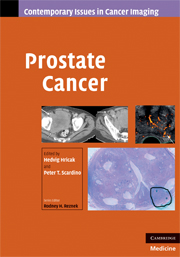Book contents
- Frontmatter
- Contents
- Contributors
- Series Foreword
- Preface
- 1 Anatomy of the prostate gland and surgical pathology of prostate cancer
- 2 The natural and treated history of prostate cancer
- 3 Current clinical issues in prostate cancer that can be addressed by imaging
- 4 Surgical treatment of prostate cancer
- 5 Radiation therapy
- 6 Systemic therapy
- 7 Transrectal ultrasound imaging of the prostate
- 8 Computed tomography imaging in patients with prostate cancer
- 9 Magnetic resonance imaging of prostate cancer
- 10 Magnetic resonance spectroscopic imaging and other emerging magnetic resonance techniques in prostate cancer
- 11 Nuclear medicine: diagnostic evaluation of metastatic disease
- 12 Imaging recurrent prostate cancer
- Index
- Plate section
- References
3 - Current clinical issues in prostate cancer that can be addressed by imaging
Published online by Cambridge University Press: 23 December 2009
- Frontmatter
- Contents
- Contributors
- Series Foreword
- Preface
- 1 Anatomy of the prostate gland and surgical pathology of prostate cancer
- 2 The natural and treated history of prostate cancer
- 3 Current clinical issues in prostate cancer that can be addressed by imaging
- 4 Surgical treatment of prostate cancer
- 5 Radiation therapy
- 6 Systemic therapy
- 7 Transrectal ultrasound imaging of the prostate
- 8 Computed tomography imaging in patients with prostate cancer
- 9 Magnetic resonance imaging of prostate cancer
- 10 Magnetic resonance spectroscopic imaging and other emerging magnetic resonance techniques in prostate cancer
- 11 Nuclear medicine: diagnostic evaluation of metastatic disease
- 12 Imaging recurrent prostate cancer
- Index
- Plate section
- References
Summary
Introduction
The role of imaging in the management of prostate cancer has long been controversial, and imaging continues to be both overused and underused. Guidelines are available regarding the use of imaging for the assessment of advanced disease. However, in recent years, imaging technology has matured, image acquisition and interpretation have improved, and a host of clinical studies have demonstrated the potential of imaging for improving other aspects of prostate cancer care, including the detection of local primary or recurrent disease and surgical or radiation treatment planning. This review will discuss the many ways in which imaging can contribute to the evidence-based clinical management of prostate cancer, focusing on the most commonly used cross-sectional imaging modalities: transrectal ultrasound (TRUS), computed tomography (CT), magnetic resonance imaging (MRI), radionuclide bone scanning, positron-emission tomography (PET), and combined PET/CT.
Imaging in diagnosis
Prostate-specific antigen (PSA) testing and digital rectal examination (DRE) continue to be the mainstays of prostate cancer detection. When either of these yields abnormal results, TRUS-guided biopsy is performed. The initial biopsy session will detect cancer in about 29% of patients who undergo biopsy for suspected prostate cancer, depending on the PSA level and DRE results. However, the sensitivity for detection is about 80%–90%, depending on the biopsy scheme used [1, 2]. Cancers missed by systematic transrectal biopsy may be small or located in the anterior part of the gland, an area rarely sampled [3].
- Type
- Chapter
- Information
- Prostate Cancer , pp. 29 - 42Publisher: Cambridge University PressPrint publication year: 2008



